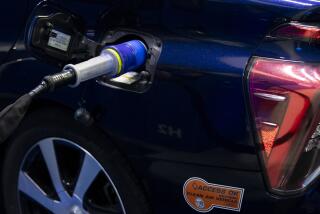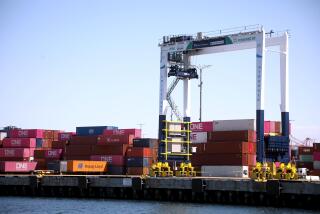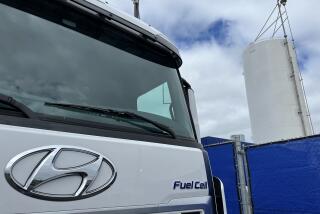Gassing Up Fuel Cells
HONEOYE FALLS, N.Y.--The hum emanating from the pickup truck comes from the same power source that has provided electricity for space shuttles and Apollo rockets: a fuel cell.
But whereas those cells are powered by pure hydrogen stored in on-board tanks, this system--developed by General Motors Corp.--uses gasoline converted to hydrogen on board the modified Chevrolet S-10.
The pickup is the first drivable gasoline-powered fuel cell vehicle, GM said.
The truck is significant because a persistent obstacle to widespread use of low-polluting or nonpolluting fuel cells in cars and trucks has been how best to obtain the hydrogen that produces the electricity used to power them.
It is easier to extract hydrogen from methanol or natural gas, but gasoline is the only one of the fuels already widely available to motorists.
With 180,000 filling stations in the U.S. “it makes sense to make the gasoline stand the refilling spot,” said Larry Burns, GM’s vice president for research and development.
The system works by mixing low-sulfur gasoline with air and water, then passing the mixture over a series of catalysts that extract the hydrogen.
The hydrogen then is routed to the fuel cell stack, where it is combined with oxygen from the air to produce electricity.
Environmentalists worry that the experimental gasoline fuel cell still emits carbon dioxide. But GM said the levels are as much as 50% less than from an internal-combustion engine. And the system achieves up to 40% overall energy efficiency--50% better than a combustion engine and the equivalent of 40 miles per gallon.
Driving the truck during a demonstration at the auto maker’s fuel cell research facility in upstate New York last week revealed a vehicle that is noisy at idle. The fuel pump is audible, though that noise should eventually be eliminated. Passengers also can hear the air compressor, sounding like a hair dryer, and a whine from the electric motor.
That motor produces 25 kilowatts of power, about 33 horsepower, which is boosted by a large battery to a total of about 100 horsepower. The battery is kept charged by electricity from the on-board fuel cell.
The system hums and hisses, and it emits a cloud of water vapor and carbon dioxide from the tailpipe.
At speed, the truck produces smooth, normal responses, although at 6,300 pounds--2,500 more than a conventional S-10--it is heavy. It takes a slug-like 15 seconds to accelerate from a standstill to 60 mph.
GM said the goal at present is efficiency rather than performance but insisted that fuel-cell-powered versions of the S-10 with performance comparable to that of internal-combustion versions could reach the market by 2010.
Virtually all auto makers are deep into researching fuel cells. They are seen as the ultimate nonpolluting propulsion system once pure hydrogen becomes the fuel. GM’s proposed system is an interim step.
“If you start with gasoline, you still get CO2 as a pollutant, whereas if you store the hydrogen as a compressed gas, you just get water vapor,” said David Eisenhaure, chief executive of SatCon, a Cambridge, Mass., company that produces systems that convert DC power from fuel cells into AC power for industrial applications.
Still, he said, “the gasoline reformer is a fine step to get people on the way” toward a pure hydrogen propulsion system.
And hydrogen, said GM’s Burns, “is the way of the future.”
The goal, he said, is “to get the automobile out of the energy and environmental debate altogether.”






